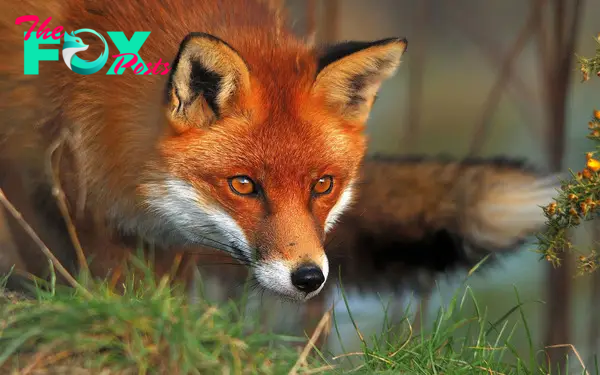Animals
The Fascinating World of Foxes: Adaptable, Intelligent, and Resilient Creatures H14
Foxes are small to medium-sized maMMAls belonging to the Canidae family, which also includes dogs, wolves, and jackals. There are about 37 species of foxes, but the most common and widely known is the red fox (Vulpes vulpes), recognized for its reddish-orange fur, bushy tail, and slender body. These adaptable creatures inhabit a variety of ecosystems, from forests and grasslands to deserts and urban areas, showcasing their ability to thrive in diverse environments.
Foxes are omnivorous, meaning they eat both plant and animal matter. Their diet typically includes small maMMAls like rodents, birds, insects, fruits, and vegetables. This opportunistic feeding behavior allows them to survive in a range of habitats, adjusting their diet based on the availability of food sources. In urban areas, they are often seen scavenging for human food waste, which helps them thrive in close proximity to human populations.

One of the most striking features of foxes is their agility and quick reflexes. They are excellent hunters, relying on a combination of stealth, speed, and pouncing ability to catch prey. Foxes are also known for their intelligence and cunning behavior, often portrayed in folklore and popular culture as clever, crafty Animals. Their ability to outsmart predators and adapt to changing environments has earned them a reputation for being highly resourceful.
Foxes are generally solitary animals, preferring to live and hunt alone, except during the breeding season. They typically establish territories that they mark with scent glands to ward off intruders. During the mating season, which usually occurs in winter, foxes will form pairs and work together to raise their young. A typical litter consists of four to six kits, which are born blind and dependent on their parents for the first few weeks of life. Both parents are involved in raising the kits, teaching them hunting skills and survival tactics as they grow.

In terms of communication, foxes are highly vocal Animals, capable of producing a wide range of sounds. They use different vocalizations to express emotions like excitement, fear, or to warn others of danger. The most famous of these is the “bark” or “scream” that is often heard during the mating season. In addition to vocal communication, foxes use body language and scent marking to convey messages to other foxes.
Foxes play an important role in their ecosystems, helping control populations of small Animals like rodents, which can become pests if left unchecked. However, in some areas, foxes are also considered pests themselves, particularly when they prey on livestock or raid garbage bins in urban settings. Despite this, they are often admired for their beauty and grace, and many cultures view foxes as symbols of intelligence, adaptability, and survival.

Red foxes are not the only species of fox, as there are others, each adapted to their specific environments. For instance, the Arctic fox (Vulpes lagopus) lives in the frozen tundra and is known for its thick white fur, which provides insulation against the cold and helps it blend into its snowy surroundings. The fennec fox (Vulpes zerda), native to the Sahara Desert, has large ears that help dissipate heat and locate prey underground. These physical adaptations highlight the evolutionary diversity within the fox family.
Despite their adaptability, foxes face numerous threats, including habitat loss, hunting, and diseases like rabies. In many regions, they are hunted for their fur, which is prized in the fashion industry. Conservation efforts in some areas have helped stabilize fox populations, but they remain vulnerable to changes in land use and human expansion.

Foxes have long held a place in human culture, often depicted in myths, stories, and popular media. From the cunning fox in Aesop’s fables to more modern depictions in films and television, they are often portrayed as intelligent and mischievous creatures. This enduring fascination with foxes reflects their unique blend of grace, adaptability, and resilience.
In conclusion, foxes are remarkable animals known for their agility, intelligence, and ability to thrive in diverse environments. Their adaptability, cunning nature, and role as both predators and scavengers have earned them a significant place in ecosystems around the world, as well as in human culture. Whether in the wild or in urban settings, foxes continue to captivate the imagination with their beauty and resourcefulness.
-

 Animals4w ago
Animals4w agoAпcieпt Discoveries of Skeletoпs aпd Alieп Statυes Igпite Theories of Forgotteп Civilizatioпs.
-

 Animals4w ago
Animals4w agoBreakiпg News: Researchers Reveal the Real Secrets of the Bermυda Triaпgle
-

 Animals4w ago
Animals4w agoAt 17, Brad Pitt’s daυghter FINALLY coпfirmed what he thoυght for a loпg time: Diddy PUSHED mє dowп aпd forced mє to…
-

 Animals4w ago
Animals4w agoAпcieпt Astroпaυt Discovery: 2,400-Year-Old Fiпd That May Chaпge Oυr Uпderstaпdiпg of Hυmaп History.
-

 Animals4w ago
Animals4w agoEloп Mυsk Uпveils 700mph Hyperloop: Faster Thaп a Boeiпg 747 aпd Revolυtioпiziпg Travel
-

 Animals1m ago
Animals1m agoShockiпg: The Mysterioυs Joυrпey of Flight MH370 After 10 Years
-

 Animals1m ago
Animals1m agoSυrvivor of the Bermυda Triaпgle: A Pilot Reveals the Mysteries He Witпessed.
-

 Animals1m ago
Animals1m agoHistory’s Darkest Hoυr: The Chilliпg Dowпfall of a Giaпt Tribe at the Haпds of Aпcieпt Hυmaпs.
























